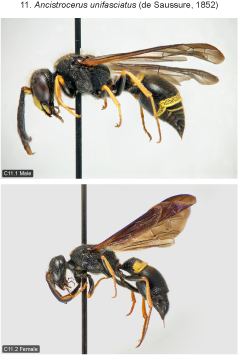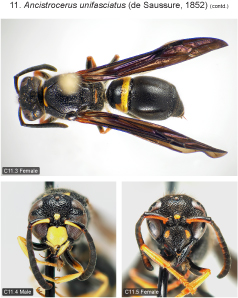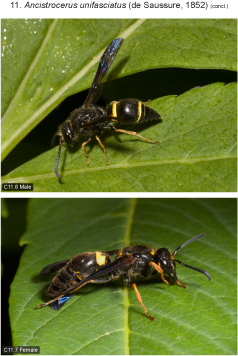
| Home | Table of contents | Keys | Species list | Glossary | Image data | PDF | Cite this article | Feedback | Updates |
Identification Atlas of the Vespidae (Hymenoptera, Aculeata) of the northeastern Nearctic region
CJAI 05, February 19, 2008
doi: 10.3752/cjai.2008.05
Matthias Buck, Stephen A. Marshall, and David K.B. Cheung
Department of Environmental Biology, University of Guelph, Guelph, Ontario, Canada N1G 2W1
Next species | Previous species | Key
11. Ancistrocerus unifasciatus (de Saussure, 1852)
Figs B2.39; B3.2, 34, 35; C11.1–7.
 |

|
 |
Species recognition. Ancistrocerus unifasciatus is easily recognisable in both sexes. It is the only species of Ancistrocerus in the area covered by this Atlas with the following characters: male vertex with a low, impunctate swelling behind the ocelli (vertex strongly punctate in other species); female metasoma black except for yellow apical fascia of tergum 1 (tergum 2 exceptionally with a narrow, irregular apical fascia; in other species at least tergum 2 has a well-developed apical fascia).
Variation. Fore wing length 6.5–9 mm (♂♂), 9.5–12 mm (♀♀). Markings of female head orange-yellow to ferruginous. Interantennal spot exceptionally absent in female. Inner orbit often with narrow yellow stripe above clypeus in male, in female often with reddish spot. Female clypeus with a pair of reddish dorsal spots, rarely missing; male clypeus yellow, rarely with a narrow black median stripe extending from base to middle of clypeus, the lower end exceptionally widened to form a black spot. Female mandible black to extensively reddish. Postocular spot sometimes almost completely reduced in male. Pronotal band usually restricted to median 2/5 of pronotum, in female rarely, in male sometimes extending to humeral angle. Mesopleuron rarely with a small orange-yellow dorsal spot in female, exceptionally present in male. Metanotal band usually complete, in male rarely interrupted medially or completely absent. Tergum 1 sometimes more or less reddish along inner margin of lateral forward extension of apical fascia. Tergum 2 rarely with narrow apical fascia in female, in this case preapical area sometimes with yellow interspaces between black punctures. Tergum 3 usually with narrow fascia in male, often also tergum 4. Sternum 1 with more or less yellowish apical margin, sternum 2 with well developed fascia in male, rarely with narrow fascia in female; male sternum 3 with posteroapical yellow spots, rarely absent or with complete fascia, male sternum 4 rarely with small posteroapical spots, as well.
One exceptional male from Point Pelee, Ontario has the clypeus black with a pair of large yellow spots on its dorsal half and pair of small, ill-defined reddish-yellow spots near clypeal apex. The specimen is not stylopized.
Distribution. Canada: ON and QC, newly recorded from PE (photographic record, Bugguide). Eastern U.S. west to IA, KS, TX (Bequaert 1944a, Krombein 1979). The ssp. seminole Bequaert, 1943 occurs in Florida.
Biology. Nests in old mud dauber nests (Krombein 1979). While there are several species of Eumeninae (especially in the genus Ancistrocerus) that occasionally nest in abandoned mud-dauber nests A. unifasciatus appears to have a strong preference for this type of nest site. We recently found the species to be exceptionally abundant around an open barn with an extremely high density of mud-dauber nests (both Sceliphron and Trypoxylon) attached to the underside of the roof. However, the species also nests occasionally in other cavities. One female was collected while provisioning a nest in a sign made from corrugated plastic with rectangular cells (inner width 4 x 5 mm) near Oakville (Ontario) (S.M. Paiero, University of Guelph). The sign was located in a barn, i.e., in a place where mud dauber nests, the primary nest site of the species, are typically found.
Next species | Previous species | Key
| Home | Table of contents | Keys | Species list | Glossary | Image data | PDF | Cite this article | Feedback | Updates |
